| Columns Retired Columns & Blogs |
Krell KSA-250 power amplifier Measurements
Sidebar 1: Measurements
There is some diversity of opinion over whether an amplifier under bench testing should be supplied with whatever AC power comes from the wall (as it would see during normal use), or if the voltage drop should be compensated for by a Variac. The former argument asserts that the amplifier's measured performance with raw AC power is more indicative of its behavior under the conditions in which it will be used: the customer's home. The latter position holds that since AC power quality varies from location to location, one should measure the amplifier's intrinsic performance, not the amplifier's performance when supplied by an arbitrary power source. This question is particularly relevant to the Krell KSA-250 because of its ability to drive huge amounts of current into the load, current that ultimately comes from the AC power line via the mains transformer.
It's possible to maintain 120V AC to the amplifier under test, even during full-power tests into low impedances, with a Variac. A Variac is a power transformer with a variable turns ratio, adjusted by a large knob, that steps up or steps down an AC voltage. As the amplifier under test draws current and pulls down the AC line voltage, the Variac can be adjusted to maintain 120V AC to the amplifier. However, one must use a Variac with a current capability that exceeds the amplifier's maximum current draw. In the case of the KSA-250 or S/550e, this means a very large Variac, one that can handle at least 35 amperes.
After some discussion, JA and I decided that power amplifiers should be measured when supplied with the raw AC outlets since this condition reflects real-world conditions. Consequently, it should be kept in mind that maximum output power will vary slightly depending on the ability of the AC supply to maintain its voltage during heavy current draw. The AC available in Stereophile's test lab, I've found, tends to be pulled down more easily than at other locations, though JA points out that any resultant reduction in clipping power seldom amounts to more than an inconsequential fraction of a dB.
With that caveat, here are the measurements. The KSA-250's frequency response (fig.1) was flat to within 0.3dB from 10Hz to 25kHz, measured at 100W into 8 ohms. There was a slight droop in the bass below 100Hz and a 0.2dB rolloff at 20kHz. The audibility of a 0.2dB rolloff at 20kHz is open to debate. Frequency response was identical regardless of output power or load impedance.
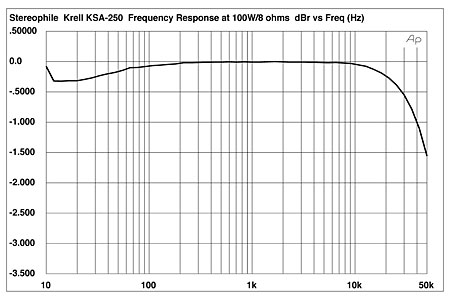
Fig.1 Krell KSA-250, frequency response at 100W into 8 ohms (0.5dB/vertical div.).
THD+Noise at moderate to high output powers was typically 0.1% through most of the band, rising to 0.2% at 20kHz. When driving low impedances, and at low output levels, distortion varied considerably with frequency. Fig.2 shows THD+Noise measured at 100W into 8 ohms (top trace at 100Hz), at 1W into 8 ohms (bottom trace at 100Hz), at 2W into 4 ohms (next trace up), and at 4W into 2 ohms (third trace up at 100Hz). These distortion figures are generally low, but higher than those of the Threshold S/550e. Note also that at the low levels, the distortion rises in the treble above the distortion at 100W.
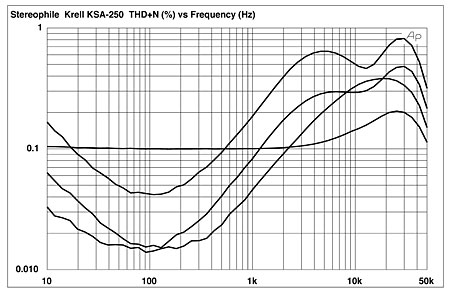
Fig.2 Krell KSA-250, THD+N (%) vs frequency at (from top to bottom) at 100Hz): 100W into 8 ohms, 4W into 2 ohms, 2W into 4 ohms, 1W into 8 ohms.
The Audio Precision System One's "Reading" monitor output removes the fundamental frequency from the signal, leaving only the distortion products and noise for viewing on an oscilloscope. Fig.3 shows the KSA-250's output at 1W into 8 ohms when driven by a 1kHz signal as captured with an 8-bit Heath digital storage 'scope. The top trace shows the 1kHz fundamental, while the lower trace shows the harmonic products. Note the nearly perfect sinewave nature of the distortion and its 2kHz periodicity, indicating that it is almost pure second harmonic, which could well correlate with the Krell's sweet sound. (The distortion component's amplitude scale has been expanded for clarity.) Fig.4 shows a 10kHz signal (top trace) at 1W into 8 ohms with its attendant distortion products (bottom trace). Again the distortion waveform has had its amplitude increased for clarity, but compared with fig.3, note the increased content of harmonics higher than the second (though with a 10kHz signal, none of these will be audible, of course, unless they contribute to downband cross-modulation products).
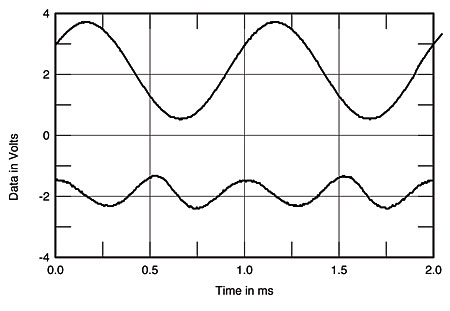
Fig.3 Krell KSA-250, 1kHz waveform at 1W into 8 ohms (top), 0.047% THD+N; distortion and noise waveform with fundamental notched out (bottom, not to scale).
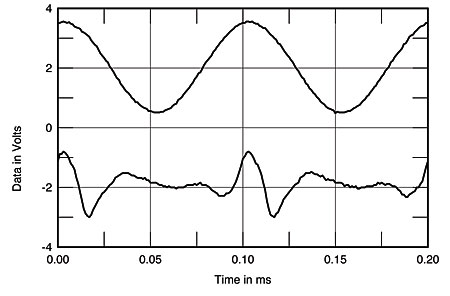
Fig.4 Krell KSA-250, 10kHz waveform at 1W into 8 ohms (top), 0.3% THD+N; distortion and noise waveform with fundamental notched out (bottom, not to scale).
Looking at the KSA-250's maximum output power into varying impedances (see Sidebar "Class-A?") with one channel driven with a 1kHz probe signal (fig.5, which plots THD+Noise vs output power), we can see it clips (1% THD) at 325W into 8 ohms (25.1dBW), at 635W into 4 ohms (25dBW), and at over 1000W into 2 ohms (actually 1066W at 0.97% THD, or 24.3dBW). When driving 1 ohm, the KSA clipped at 1548W (22.9dBW). This is approaching perfect voltage-source behavior, and could be expected to be closer to the ideal of a doubling of power with each halving of impedance if the AC line voltage were held constant. The AC line voltage sagged during these tests to 116V (8 ohm testing), 114V (4 ohm testing), 112V (2 ohm testing), and 106V (1 ohm testing), from 117V at idle. All maximum power output measurements exceeded Krell's specifications except the 1 ohm measurement, which is a result of the line voltage dropping so low. With a regulated AC voltage, the KSA-250 could probably be expected to put out 2kW into 1 ohm. Although Krell specifies a 4kW output rating in 0.5 ohms, I didn't have a half-ohm resistor that would handle such power.
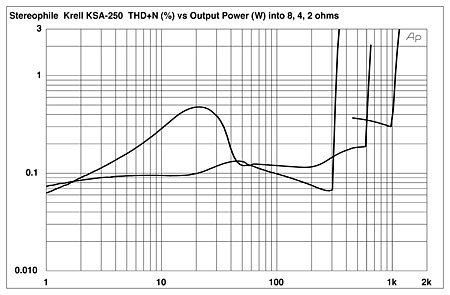
Fig.5 Krell KSA-250, distortion (%)vs 1kHz continuous output power into (from bottom to top at 300W): 8, 4, 2 ohms.
Output impedance was a constant 0.13 ohm measured at 20Hz, 1kHz, and 20kHz, slightly higher than the S/550e's 0.08 ohm, and fairly typical of a solid-state amplifier. This figure may be slightly higher than the KSA-250's actual output impedance due to the lengths of cable between the amplifier (which was on the floor) and the test load, and between the load and the System One. (Ideally, the load and measuring device should be attached directly to the output terminals, with no intervening cable.) Crosstalk was quite good at greater than 70dB through most of the band, but decreased to 56dB at 20kHz.—Robert Harley
- Log in or register to post comments




































